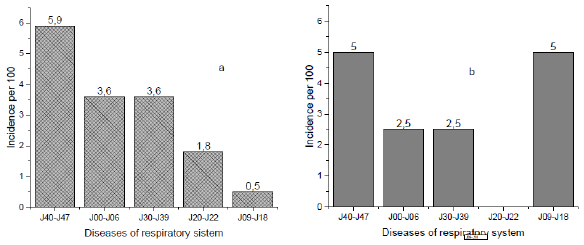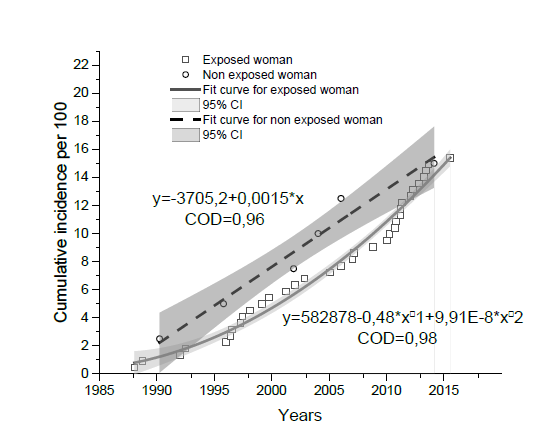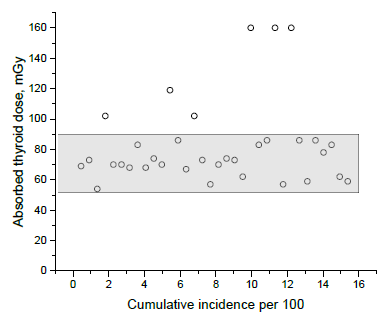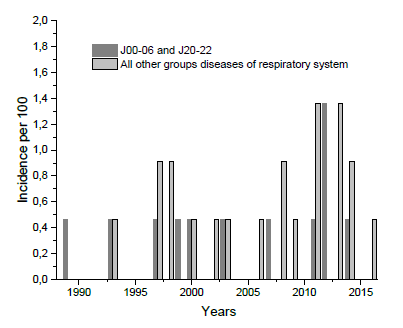Research Article 
 Creative Commons, CC-BY
Creative Commons, CC-BY
Delayed Consequences of The Radioactive Iodine Intake by Pregnant Women from The Side of Respiratory System
*Corresponding author: Alexander N Stojarov, Department of Radiation Medicine and Ecology, Belarusian State Medical University, 220116, Minsk, Belarus, Tel: +375297560223.
Received: December 22, 2021; Published: January 12, 2022
DOI: 10.34297/AJBSR.2022.15.002092
Abstract
In this study we investigated non-cancer effects of irradiation caused by radioactive I-131. Namely, we studied incidence of pathology of respiratory system in women who were pregnant in time of the accident at Chernobyl power nuclear plant and received absorbed doses by their thyroid glands. The development of respiratory tract diseases is associated with absorbed doses by thyroid gland in the rage of 50 - 100 mGy with a strong maximum at 75 mGy. The peak of the incidence of respiratory tract diseases manifestation was in the year of 2012. So, there may be a tendency of the development of such diseases 25 years after the irradiation. Obtained data are interpreted considering the possible influence of I-131 intake on gene regulation and endocrine and immune systems functioning in pregnant women, that might lead to the delayed consequences from the side of in respiratory system.
Keywords: Chernobyl accident, Pregnant women, I-131, Diseases of respiratory system
Abbreviations: TG: Thyroid Gland; DRS: Diseases of Respiratory System
Introduction
The interest to the non-cancer consequences of the exposure to the irradiation is growing among researchers. Stochastic effects of irradiation, namely, the increase of the risk of cancer development after a certain period of latency, are already well described for tumors of different locations [1]. Somatic pathology that occurs after irradiation in a certain period is still a subject for investigations.
Studies of consequences of Chernobyl disaster that happened in 1986 are very important, since the number of affected people is too high, especially, among citizens of Belarus. Different victims of the Chernobyl disaster obtained different doses of irradiation, both for the entire organism (outer and inner ones) and for each organ (namely, for the thyroid gland). Those victims belonged to different strata of the population. One of those specific groups of the population is the group of pregnant women. It is quite understandable that during the pregnancy all the systems of organs (endocrine, nervous, immune, secretory etc.) are overstrained from the point of view of physiology. Numerous regulatory functions are associated with the activity of thyroid gland. Radioactive Iodine has formed an absorbed dose of irradiation after the explosion in Chernobyl nuclear power plant. So, in this study we analyzed a specific case of irradiation by radioactive I-131 that was accumulated in thyroid glands of both pregnant women and their fetuses.
Previously we studied somatic pathology in women irradiated during their pregnancy by I-131 [2] and found out that in this cohort of population essential hypertension prevails after a certain period [3]. So, it is intriguing to check possible connections between the development of pathology of other organs and systems of organs and the exposure to I-131 during pregnancy.
In this study we analyzed diseases of respiratory system in the group of women irradiated by I-131 when they were pregnant. The data on such consequences of irradiation are quite limited. However, there is an information on the increase of the risk of the development of respiratory diseases among victims of the nuclear attack of Hiroshima and Nagasaki [4].
Materials and Methods
We studied a cohort of women who lived in Stolin district of the Brest region of Belarus in 1986 and were at different stages of pregnancy. The radioactive cloud travelled through that region in the night of April 26 in 1986. There was a mixture of radionuclides in that cloud that included radioactive I-131. That nuclide was accumulated by thyroid glands of exposed people and formed an absorbed dose of different values. First, radioactive I-131 was getting inside by the way of inhalation, and then it started to be consumed with the food (mostly with the whole milk). Unfortunately, people were not protected from I-131 by the way of the blockade of a thyroid gland by stable Iodine. They were evacuated late. Also, consumption of the whole milk of local cows has not been prohibited.
Only those women (N=221) who were included in the Republican register of persons suffered from Chernobyl disaster are included in the current study. Those women underwent medical examination on a regular basis, according to the prescriptions of the legal system of Belarus. At the time of explosion those women were at the age of 17 - 44 years (26.2±0.4, the median is 25 years).
Doses absorbed by the thyroid gland due to I-131 incorporation were calculated by the head of the laboratory for the reconstruction of radiation doses for the population of the State Research Center of the Federal Medical Biophysical Center named after A.I. Burnazyan Federal biomedical agency (FMBA) of Russia, Doctor of Technical Sciences, Shinkarev S.M. Doses were calculated using a semiempirical 2004 iteration model. In addition, for some cases, doses absorbed by the thyroid gland were determined based on the data of radiometric, so-called “direct” measurements of the exposure dose rate over the area of this organ, carried out from April 26 to June 30, 1986 [5]. The absorbed dose for a thyroid gland in the studied cohort of women ranged from 48 to 246 mGy.
We included 40 women in the control group. They lived in the same district of the Brest region in identical conditions, but they got pregnant later, i.e., in 1987. By that time, I-131 disintegrated almost completely and therefore, at the time of pregnancy, absorbed doses by their thyroid glands had not been formed. However, the same living conditions in the contaminated area of the district formed a general exposure in the surveyed women, which was practically the same as in the main group. The age of women in the control group at the time of the accident varied from 16 to 35 years (24.1±0.9, the median is 22 years).
Total doses (1986 - 2016) occurred due to the living in the contaminated area were calculated using the RESRAD-ONSITE software, version 7.2 (Enviromental Science Division of Argonne National Laboratory, USA). The density of the surface activity of the soil of the Stolin district for Cesium-137 was provided by the State Institution “Republican Center for Hydrometeorology, Control of Radioactive Contamination and Environmental Monitoring”.
The morbidity data were obtained from the State Register of Persons Affected by the Chernobyl Accident. It is important to state that in this work we took into account only the primary morbidity.
Statistical data processing was carried out using the applied computer programs Statistics 10.0 (StatSoft.Inc, USA) and SigmaPlot 12.5 (Systat Software Inc., Germany).
This study was approved by the Ethics Commission of the Belarusian Association of Physicians (10.12.2020).
Results
In the main group the total morbidity with diseases of respiratory system is 15.4 per 100, while in the control group it is equal to 15.0 per 100. This small difference is not significant according to the results of χ2 test. The analysis of the structure of that morbidity has also been performed (Figure 1). First, we have to pay attention to the group of diseases with a code J09-J18. According to the International Classification of Diseases ICD-10, viral and bacterial pneumonia, as well as Influenza are included in this group. The incidence of such diseases is 10 times higher among women from the control group (5.0 per 100) than among women from the main group (0.5 per 100). That significant difference is caused by the presence of two women who suffered from pneumonia among the control group and the presence of just a single case in the main group.
Chronic lower respiratory diseases J40-J47 are making the main contribution into the overall morbidity by respiratory system diseases in the main cohort of women (Figure 1a). The difference between the incidence of chronic lower respiratory diseases for women exposed during pregnancy and those who got pregnant later is insignificant.
For the group J30-J39 (Other diseases of upper respiratory tract) the difference between two cohorts is also insignificant. In the main group the incidence of such diseases is equal to 3.6%, while for the control group it is equal to 2.5%. The same situation is there (Figure 1) for the group of diseases under the code J00-J06 (Acute upper respiratory infections).

Figure 1: The structure of diseases of respiratory system in a cohort of women who were exposure to the radioactive iodine during pregnancy (a) and in a cohort of women who were not exposed during pregnancy (b).
Interestingly, among women who were not irradiated during the pregnancy, means in the control cohort, there are no cases (Figure 1b) of diseases grouped under the code J20-J22 (Other acute lower respiratory infections).
So, in general, the morbidity itself and its structure are quite similar in women from both cohorts.
Cumulated morbidity for diseases of respiratory system during the period from 1986 to 2016 is shown in Figure 2. It is clearly seen that morbidity is growing in time for both cohorts. Moreover, the values of incidence in the beginning and in the end of the graph are almost identical for both cohorts. However, the best fit trends of those dependencies are different. For the control group the trend is linear, while for the main group the trend is parabolic. There is a steeper increase in morbidity after the year of 2011 (Figure 2).

Figure 2: Cumulative incidence (from 1986 till 2016) of diseases of respiratory system in irradiated women who were pregnant in 1986.
Because of the «Iodine strike» happened in first days after the Chernobyl disaster different absorbed doses by the thyroid gland were formed. That is why we checked the dependence between the absorbed dose and the occurrence of diseases of respiratory system. As one can see in Figure 3 the total morbidity for diseases of respiratory system relates to certain absorbed doses by the thyroid gland. Those doses are in the rage from 50 to 90 mGy.

Figure 3: Cumulative incidence of diseases of respiratory system depending on the dose absorbed by the thyroid gland among women exposed to radioactive iodine during pregnancy.
The analysis of morbidity for all types of respiratory system diseases in year-by-year manner showed that the highest incidence in women exposed during the pregnancy was registered in 2012, i.e. 25 years after the Chernobyl disaster (Figure 4). In the control cohort that peak has not been found. Morbidity was at the same level of 2.5 cases per 100 people for women who were not pregnant during the time of the «Iodine strike».

Figure 4: The incidence of diseases of respiratory system (from 1986 to 2016) in pregnant women who were irradiated by I-131 due to the Chernobyl accident.
Analysis of the incidence of two groups of diseases taken together (J00-06 and J20-22) against the incidence of all other diseases of respiratory tract showed that in the first group there is just a single peak exactly in 2012, but in the second group there are several peaks, including those in 2011 and 2013 (Figure 5).
The most important finding of the study is in the fact that there is a peak of an absorbed dose by the thyroid gland that corresponds to the highest frequency of occurrence of respiratory tract diseases, and it has a value of 75 mGy (Figure 6).

Figure 5: The incidence of acute diseases of upper and lower respiratory tract and other respiratory diseases (from 1986 to 2016) in pregnant women who were irradiated by I-131 due to the Chernobyl accident.

Figure 6: Dose dependence of the incidence of diseases of respiratory system in the group of women who were pregnant in the time of Chernobyl disaster.
Discussion
Analysis of the data presented in the current article is interesting because of several reasons. First of all, there are almost no data on the influence of ionizing radiation on the respiratory system. At second, there are no data on the effects of irradiation of thyroid gland by the radioactive Iodine on the development of pathology of respiratory system. And, finally, the data on women who were irradiated during pregnancy are limited.
The main conclusion of the current study is in the fact that there is a connection between the irradiation of thyroid gland during the pregnancy by the radioactive iodine and the morbidity of respiratory system. This conclusion is supported by the narrow range of absorbed doses by the thyroid gland (around 75 mGy) that have led to the increase of such morbidity after 25 years. It is important to highlight that low dose (less than 50 mGy), as well as doses higher than 100 mGy did not show any influence on the incidence of respiratory system diseases.
Among the studied diseases there are both acute and chronic ones. However, chronic diseases of respiratory system dominate in both cohorts of women: in those who were irradiated during pregnancy and in those who were not pregnant during the “Iodine strike”. Indeed, acute diseases might not be registered, unlike chronic ones. Ineffective treatment or the lack of professional treatment of acute diseases of respiratory system might led to the development of chronic diseases.
Women, who were irradiated during the pregnancy, demonstrated 10 times lower incidence of acute diseases of upper and lower respiratory tract. What is the reason of this decrease? It is hard to guess that irradiation during pregnancy somehow helped them to cope with viral and bacterial diseases, including pneumonia. It is more likely that the initial diagnosis in those women revealed other chronic or acute diseases. Probably, the effect of irradiation during the pregnancy can cause deviations from the typical clinic manifestations of Influenza infection, since the diagnosis is usually made without PCR or ELISA testing, but based on clinical symptoms (i.e., strong hyperthermia). Moreover, Influenza is much more frequently diagnosed if a person becomes sick during the epidemic. So, women who were irradiated during the pregnancy seem to suffer from acute diseases of respiratory tract in different seasons of the year, and they were rarely diagnosed with Influenza. Another possible explanation of the observed difference is in the lack of acute pneumonias among women from the main group.
Experiments showed that there are at least 27 genes that are sensitive to the influence of radioactive iodine in thyrocytes [6]. Some of them have a mutual connection to the immune system: Ccl8, Ccl9, Ly6g6d, St00a9, Aoc3, Clec2d, Cpa3, Fstl1, Scara3. Expression of those genes is different at different absorbed doses of irradiation. For example, Ccl9 gene, that is situated on the chromosome 11, is downregulated at the absorbed dose of 0.85 Gy, while at the absorbed dose of 17 Gy its expression is more than 2 times higher than in normal conditions. The product of this gene participates in the control of activity of immune system, in inflammation, and in the modulation of cytokine system.
It is likely that permanent changes in expression of abovementioned genes caused by the “Iodine strike” led to some changes in the reactivity of immune system, and so to the blurring of symptoms of acute respiratory diseases that caused the decrease in the diagnosis of Influenza and acute pneumonias.
Another explanation of the obtained results may be in the change of expression of genes that control the production of thyroid gland hormones. Indeed, those hormones (especially Т3) can modulate the activity of immune system [7] at least by the way of modulation of phagocytosis and the release of active forms of oxygen. Both T3 and T4 modulate immune reactions in natural killers, in monocytes, in macrophages, in leucocytes and lymphocytes [9]. Hormones of thyroid gland also regulate some functions of the respiratory system [8] like the tidal volume in adults (mostly because of the change in the structure of connective tissue and in the strength of respiratory muscles). Also, those hormones may induce hypersensitivity reaction leading to the constriction of bronchi. On the other hand, the same hormones stimulate the breathing center in the brain stem.
In general, irradiation causes genome instability [10, 11] resulting in the increase of the rate of occurrence of somatic mutations. The most common consequence of such somatic mutations is in the development of cancer. However, some of those somatic mutations may result in the development of non-cancer pathology after many years.
Pregnancy is a condition that requires complicated changes in the hypophysis-driven regulation of thyroid gland [12]. Levels of thyrotropic hormone, and so T3 and T4 are changing in different periods of pregnancy, as well as other biochemical indices. For example, in the end of the first trimester of pregnancy (at the 10th week) the level of thyrotropic hormone reaches its minimum, while until the 20th week its level is turning back to the normal value [13]. The level of thyrotropic hormone drives the level of Т4. Transport of Iodine through the membrane is required for the synthesis of T4. That transport depends on expression of genes like Sic5a5/ NIS and Tg [6]. In its turn, the activity of Sic5a5 gene was shown to be inhibited by low and average doses of radioactive Iodine but stimulated by high doses [6]. It means that from 10th to the 20th week of pregnancy the “Iodine strike” should be especially strong. Such enhanced exposition to the radioactive Iodine might result in the increased somatic mutagenesis and the development of both cancer and non-cancer pathology.
It is clear that stochastic effects of irradiation (i.e., cancer) demonstrate a progression in the morbidity in years and show no threshold relative to the absorbed dose. In contrast, non-cancer pathology of respiratory system in our study showed a concrete dependence on the absorbed dose and the peak of morbidity in 2012. However, we analyzed only those women that were pregnant in time of Chernobyl disaster. Taken together, obtained data are on the influence of the combination of three factors on the development of respiratory system pathology: 1) irradiation; 2) “Iodine strike”; and 3) pregnancy.
Conclusion
There is a connection between the absorbed dose by the thyroid gland (50 - 100 mGy with a maximum at 75 mGy) and the delayed rise of the incidence of respiratory tract diseases (in 2012, 25 years after the irradiation) in women who lived in Stolin district of Belarus and suffered from the intake of radioactive I-131 during their pregnancy because of the Chernobyl accident in 1986.
Conflict of Interest
Authors have no conflicts of interest.
Funding
This study did not receive any special grant from any funding agency in the government, commercial or non-profit sector.
References
- Mettler FA (2012) Medical effects and risks of exposure to ionizing radiation. J Radiol Prot 32(1): N9-N13.
- Stojarov AN, Khrustalev VV, Odinzova Stojarova DA (2021) Non-cancer morbidity of women irradiated during pregnancy due to the incorporation of I-131 as a result of the Chernobyl Accident. Intern J of Clinical studies and Med Case Reports 10(2): 1-3.
- Stojarov AN, Khrustalev VV (2021) Essential hypertension after radiation exposure. JSM Environmental Science and Ecology 9(1): 1076-1080.
- Michiko Yamada, F Lennie Wong, Saeko Fujiwara, Masazumi Akahoshi, Gen Suzuki (2004) Noncancer disease incidence in atomic bomb survivors, 1958-1998. Radiat Res 161(6): 622-632.
- Gavrilin Y, Khrouch V, Shinkarev S, Vladimir Drozdovitch, Victor Minenko, et al. (2004) Individual thyroid dose estimation for a casecontrol study of Chernobyl-related thyroid cancer among children of Belarus-part I: 131I, short-lived radioiodines (132I, 133I, 135I), and short-lived radiotelluriums (131MTe and 132Te). Health Phys 86(6): 565-585.
- Rudqvist N (2015) Radiobiological effects of the thyroid gland. University of Gothenburg, Gothenburg pp. 69.
- Perrotta C, Buldorini M, Assi E, Cazzato D, Clara De Palma, et al. (2014) The thyroid hormone triiodothyronine controls macrophage maturation and functions: protective role during inflammation. Am J Pathol 184 (1): 230-247.
- Podlaska M, Chełmińska M, Sworczak K (2003) Respiratory disorders in thyroid pathology. Wiad Lek 56(9-10): 468-474.
- De Vito Paolo, Incerpi S, Pedersen J, Luly P, Davis FB, et al. (2011) Thyroid hormones as modulators of immune activities at the cellular level. Thyroid 21(8): 879-890.
- Vorobtsova I (2006) Transgenerative transmission of radiation-induced instability of the genome. Rad Biology Radioecology 46(4): 441-446.
- Lorimore S, Wright E (2003) Radiation-induced genomic instability and bystander effects: related inflammatory-type responses to radiation-induced stress and injury? A review. Int J Radiat Biol 79(1): 15-25.
- Navid A, Faisal A, Masehullah S, Ziemnicka K, Andrzej Minczykowski (2020) Thyroid gland dysfunction and its effect on the cardiovascular system: a comprehensive review of the literature. Endokrynol Pol 71(5): 466-478.
- Gaberscek S, Zatelet K (2011) Thyroid physiology and autoimmunity in pregnancy and after delivery. Expert Rev Clin Immunol (7)5: 697-706.



 We use cookies to ensure you get the best experience on our website.
We use cookies to ensure you get the best experience on our website.